
Deck Permit – Homeowner’s Guide
Before you start building your dream deck, make sure you understand the one thing that can make or break your project – the deck permit. A building permit for a
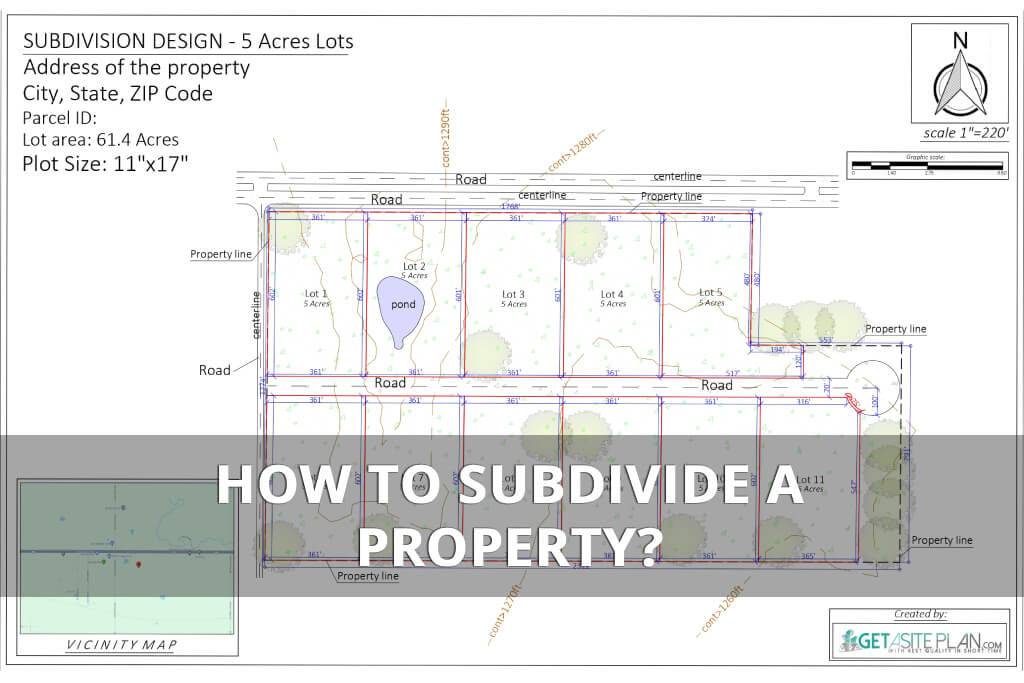

Contributing Writer | Architecture & Design Writer
Whether you want to sell part of your land, create multiple lots for development, or simply increase its value, subdivision of property can be rewarding – but it’s also highly regulated.
Therefore, subdividing property may be challenging if you don’t know how to do it and where to start.
Understanding zoning laws, requirements, and costs will save you time, stress, and money. This guide explains how to subdivide your property, including eligibility rules, a step-by-step process, and state-specific considerations.
Table of Contents
Toggle
Homeowners usually subdivide a property (split one parcel of land into two or more lots) when they want to sell part of their land, create a new buildable lot, or pass property to family members, yet in each case the process is the same.
Here’s the quick process of property subdivision:
While these steps give you a clear picture of the process, the first thing you need to determine is whether your property is eligible for subdivision (Learn more about land subdivision and how it fits into the overall development process).
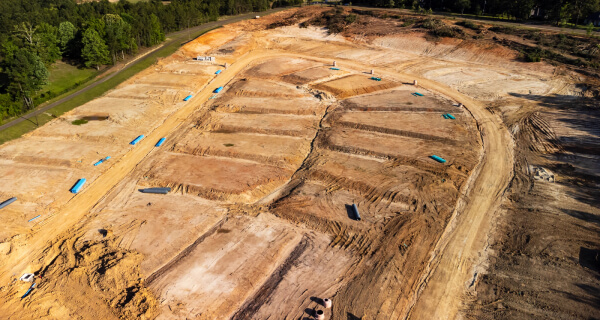
Before you begin, it’s essential to determine if your property is eligible for subdivision. Local zoning laws, land size requirements, and infrastructure access play a huge role in whether your application will be approved.

To find out if you can subdivide your property, follow these steps:
Many counties have interactive GIS maps where you can see zoning and parcel data, which may also be very helpful.
Typical requirements for property subdivision include:
Even if your property meets basic requirements, there may be additional restrictions for property subdivision:
If any of these apply, extra permits or approvals may be needed, which can add time and cost.
Generally, only the property owner or an authorized representative can submit a subdivision application. If the property is under joint ownership status, all owners must sign off.
If you have a mortgage, you’ll need written approval from your lender before finalizing the subdivision (more on this below).
If you are eligible for property subdivision, here are the steps you need to follow, in detail.
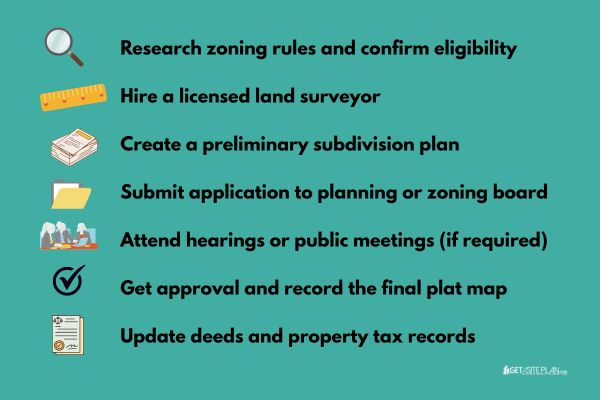
Once you’ve confirmed eligibility, here’s the complete subdivide property process, from initial research to final approval.
Start by checking the zoning classification of your land.
Subdivision rules depend on whether your property is zoned for residential, commercial, or vacant use.
Start by reviewing:
Your local planning office or council can provide maps and handbooks to help you understand these rules. Taking the time to do this research now ensures you know exactly what’s allowed helps you avoid costly delays or rejections later in the process.
This process often involves title and land boundary adjustments, so professional accuracy from the surveyor is critical.
A land surveyor will:
In almost every state, laws like the California Subdivision Map Act, Florida Statutes Chapter 177, and Washington RCW 58.17 require a licensed surveyor or engineer to map property boundaries and prepare the final legal plat for recording.
Without this step, your subdivision cannot be legally recorded.
However, if you’re still in the planning phase, you don’t have to hire a surveyor immediately. You can first create a preliminary site plan to test your idea and get feedback before moving to a full surveyor’s plat.
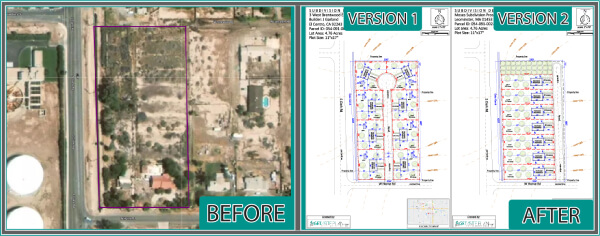
Before submitting anything for approval, you’ll need a preliminary plan showing how you want to divide your property.
The preliminary subdivision plan typically includes:
For more detail, see subdivision site plan requirements that show what local authorities expect before approval.
In many cases, a developer consults the planning authority at this stage to ensure the design meets long-term community goals. Also, for this stage, you don’t necessarily need to pay for a full surveyor’s plat just yet.
Many counties allow you to submit an informal or conceptual site plan to:
GetASitePlan’s site plan services provide accurate, professional digital subdivision site plans that meet local requirements. This is a fast, affordable way to map out your subdivision idea and discuss it with your planning department before you move on to the more expensive, legally binding surveyor work.
Once your preliminary plan is approved, you’ll proceed to finalize it with your surveyor, who will create the official stamped plat required by law.
You’ll need to prepare and submit:
At this stage, your local council approves zoning changes if needed.

Many cities require a public hearing so neighbors can voice concerns.
If so, be ready to answer questions about:
This step can be time-consuming and paperwork-heavy, so be prepared with documentation and professional support.
Once approved:
If zoning changes are needed, the council approves them before issuing a subdivision permit.
Final steps of subdividing property include:
Each new lot will now have its own valuation and can be transferred independently, giving you more flexibility and potential for profit.
Below is a simple subdivision checklist to make sure you followed each step correctly:
Considering property subdivision contains a lot of steps, the timeline isn’t short and can vary significantly based on several factors.
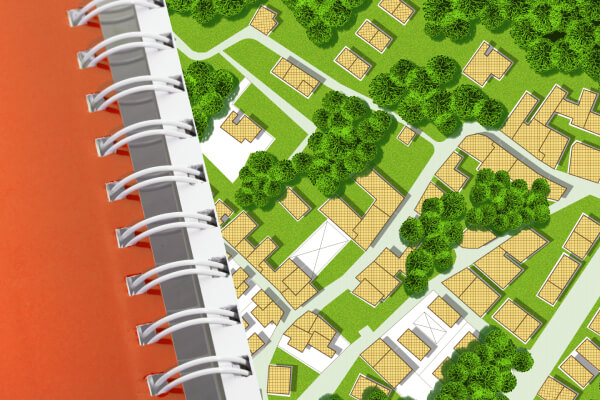
Subdividing property typically takes 3 to 12 months, depending on complexity and local regulations.
For a simple lot split, the process typically takes around 2-3 months, while a full subdivision that requires new infrastructure such as roads, utilities, or drainage systems can take 6-12 months or longer. Delays often result from public objections, permit processing, or land surveys. Also, urban properties usually process faster than rural ones.
While understanding the timeline is important, it’s equally crucial to consider the overall difficulty of the process.
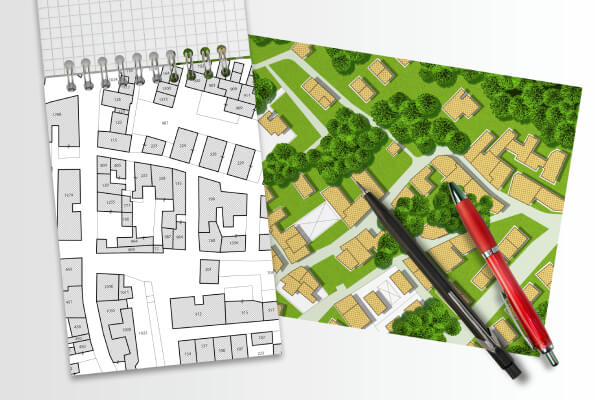
Subdividing property is moderately difficult because it isn’t necessarily hard, but it’s complex.
You’ll need to navigate legal rules, public hearings, and technical planning requirements. Also, as mentioned earlier, in many cases, you’ll need to attend public hearings and work with city or county planning departments to ensure your plans meet all requirements.
That’s why hiring experienced professionals – like a land surveyor or civil engineer or contacting online drawing services for preliminary plans can make the process smoother.
Because every state has its own regulations, the complexity of your subdivision will also depend on where your property is located.
Subdivision rules vary significantly depending on the state. Here’s a high-level look at a few popular states.

The cost to subdivide property varies based on location and complexity. Yet, the expected prices are the following:
You can take a look at an average price to subdivide a property in a table below:
| State | Surveyor Fees | Application Fees | Total Estimated Range | |
| Washington | $1,500 – $5,000 | $500 – $2,000 | $5,000 – $15,000 | |
| Florida | $1,000 – $4,500 | $400 – $1,800 | $4,000 – $14,000 | |
| Texas | $1,200 – $5,000 | $450 – $2,500 | $4,500 – $16,000 | |
| California | $2,000 – $6,000 | $600 – $2,500 | $6,000 – $20,000 | |
Table 1: Average cost to subdivide a property by state
A typical simple split to create a subdivided property costs between $5,000 and $15,000. For complex projects, costs can exceed $50,000.

Yes, you can subdivide your property with a mortgage, but you’ll need lender approval first
since your lender has a financial interest in the entire parcel.
Process of subdividing property with a mortgage:
Failing to notify your lender could cause legal issues or block the sale later.
You can subdivide property multiple times as long as each division meets zoning rules and local subdivision ordinances.
You may be unable to subdivide due to zoning restrictions, lot size limits, HOA rules, or lack of road access.
In Washington, the minimum land size to subdivide depends on zoning classification.
So, check with your county planning department for exact numbers.

Completing a subdivision can feel overwhelming, but with careful planning and professional help, the process is manageable.
Once finished, your property is divided into smaller lots, each with its own title and valuation.
Although it takes time and resources, subdivision may increase land value and usage potential, giving you flexibility to sell, build, or pass land to family members.
Start with a clear subdivision site plan to simplify approvals and speed up your project.
Learn more about our contributor:

Contributing Writer | Architecture & Design Writer
During my career, I’ve written articles on interior design, home remodeling, and renovation with an emphasis on money-saving tips and DIY ideas. It’s been a rewarding journey and I am thrilled to continue helping others bring their architectural visions to life.

Before you start building your dream deck, make sure you understand the one thing that can make or break your project – the deck permit. A building permit for a

Imagine having a modern, sustainable home that’s both stylish and tailored to your needs. Well, thanks to modular houses, you can have it. The average cost to build a modular
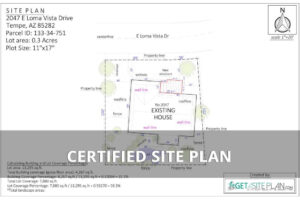
In some cases, certified site plans are the only documents that guarantee compliance and precision for accurate measurements and detailed property layouts. But what exactly does it entail, and since